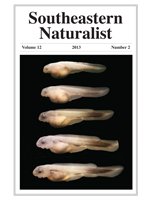Herpetofauna have declined globally, and monitoring is a useful approach to document local and long-term changes. However, monitoring efforts often fail to account for detectability or follow standardized protocols. We performed a case study at Hemlock Bluffs Nature Preserve in Cary, NC to model occupancy of focal species and demonstrate a replicable long-term protocol useful to parks and nature preserves. From March 2010 to 2011, we documented occupancy of Ambystoma opacum (Marbled Salamander), Plethodon cinereus (Red-backed Salamander), Carphophis amoenus (Eastern Worm Snake), and Diadophis punctatus (Ringneck Snake) at coverboard sites and estimated breeding female Ambystoma maculatum (Spotted Salamander) abundance via dependent double-observer egg-mass counts in ephemeral pools. Temperature influenced detection of both Marbled and Red-backed Salamanders. Based on egg-mass data, we estimated Spotted Salamander abundance to be between 21 and 44 breeding females. We detected 43 of 53 previously documented herpetofauna species. Our approach demonstrates a monitoring protocol that accounts for factors that influence species detection and is replicable by parks or nature preserves with limited resources.
How to translate text using browser tools
1 June 2013
Quantifiable Long-term Monitoring on Parks and Nature Preserves
Sharon Becker,
Christopher Moorman,
Christopher DePerno,
Theodore Simons
ACCESS THE FULL ARTICLE

Southeastern Naturalist
Vol. 12 • No. 2
June 2013
Vol. 12 • No. 2
June 2013




